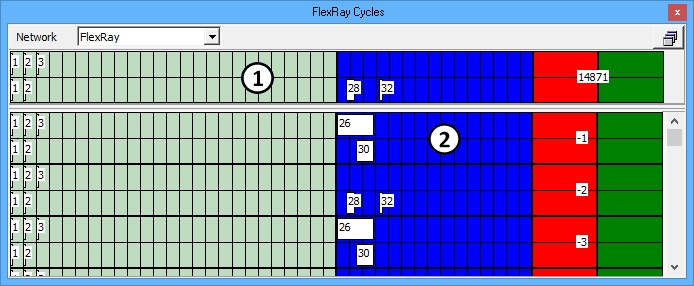FlexRay Cycles
Vehicle Spy's FlexRay Cycles view is a nice visual aid for understanding FlexRay concepts such as cycles, static frames, dynamic frames, and channels A and B. FlexRay Cycles view is opened from the Spy Networks menu.
After selecting the desired Network at the top, FlexRay Cycles view will show cluster activity for all connected nodes after going online with ICS hardware previously configured using FlexRay Controllers view.
Example of FlexRay Cycles View with an Active Cluster
Figure 1 shows an example of the FlexRay Cycles view for an active cluster. Each major row in the table represents one FlexRay cycle that has two minor rows representing channels A and B. The major row in the top window pane (Figure 1:![]() ) displays the last cycle completed. The number on the top right is the total number of frames detected. Loading a VS3 setup file resets the frame counter to zero.
) displays the last cycle completed. The number on the top right is the total number of frames detected. Loading a VS3 setup file resets the frame counter to zero.
The major rows in the lower window pane(Figure 1:![]() ) display the history of previous cycles completed. The negative numbers on the right indicate the previous cycle (-1), the next previous cycle (-2), etc.
) display the history of previous cycles completed. The negative numbers on the right indicate the previous cycle (-1), the next previous cycle (-2), etc.

Different colors show the various segments within each cycle as described in Table 1.
Table 1: FlexRay Cycles Color Codes
What Else Does the Example Show?
The example in Figure 1 shows 25 static slots and 15 dynamic slots. Both channels A and B have traffic, but not the same traffic.
Channel A Static frames 1, 2, and 3 with 20 byte payloads. No dynamic frames. Channel B Static frames 1 and 2 with 20 byte payloads. Dynamic frame 28 with 50 byte payload and frame 32 with 10 byte payload.
Channel A Static frames 1, 2, and 3 with 20 byte payloads. Dynamic frame 26 with 254 byte payload. Channel B Static frames 1 and 2 with 20 byte payloads. Dynamic frame 30 with 100 byte payload.
FlexRay Highlights
The following information is provided for quick reference regarding items on FlexRay Cycles view:
Cluster
Every FlexRay network is a cluster of nodes.
Nodes
Each node can be a coldstart or non-coldstart node.
At least two coldstart nodes are required for a cluster.
Each node can have one or two channels.
ICS FlexRay hardware has 2 coldstart nodes with 2 channels configured using **** FlexRay Controllers view.
Channels
There are two channels, A and B.
Channel B is optional.
Both channels simultaneously loop through 64 cycles.
Channels are time synchronized to each other, but not data synchronized.
Cycles
There are 64 cycles in a continuous loop from 0 to 63.
Each cycle has segments in this order: static + dynamic* + symbol window* + network idle time. (*optional)
Each cycle has a maximum of 2047 slots.
Dynamic frames can exist in every cycle or only in a subset of cycles called a "cycle set".
Cycle sets are defined with a 7 bit cycle code.
Vehicle Spy's Messages Editor defines cycle sets using Base Cycles and Cycle Reps with examples shown in Table 2.
Table 2: Examples of Cycle Sets for Dynamic Frames

Slots
A slot is a window of time when a node can transmit a frame.
Maximum number of static slots is 1023.
Frames
There are two types of frames, static and dynamic.
Frame IDs can range from 1 to 2047, with 0 being invalid.
Each frame is fully identified with a unique slot and channel, and an optional cycle code.
Each frame has a payload of an even number of data bytes up to a maximum of 254.\
Static frames must all have the same payload length.
A static frame can be sent on channel A, on channel B, or on both channels at the same time.\
Dynamic frames can have different payload lengths.
A dynamic frame can be sent on channel A or on channel B, but not on both at the same time.